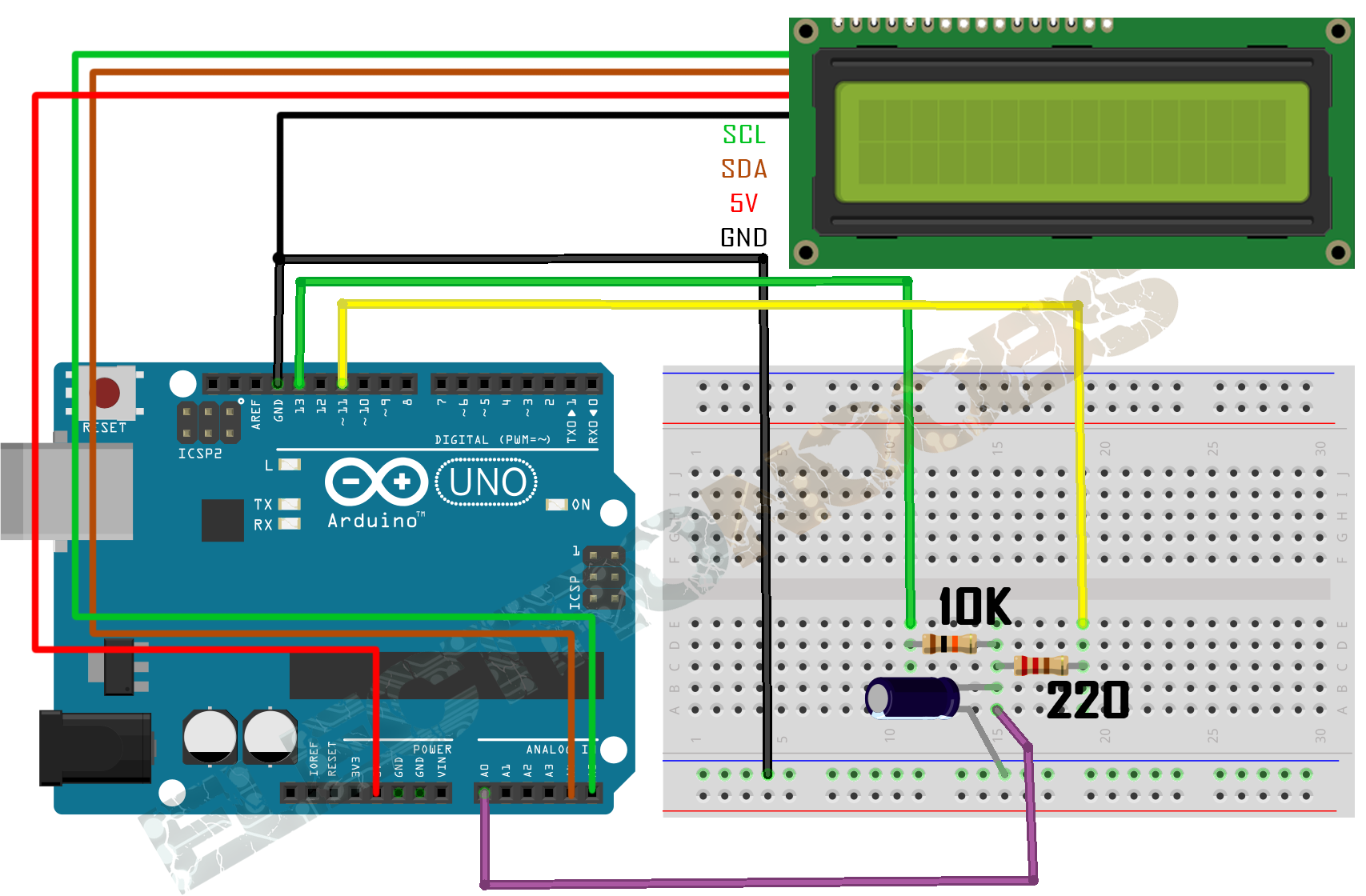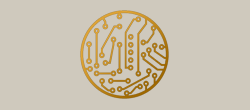Arduino multimeter BASIC
Capacitance meter
Capacitance is a measure of the ability of "something" to store electrical charge. Arduino capacitance meter relies on the same basic property of capacitors- the time constant. The time constant of a capacitor is defined as the time it takes for the voltage across the capacitor to reach 63.2% of its voltage when fully charged. Larger capacitors take longer to charge, and therefore have larger time constants. An Arduino can measure capacitance because the time a capacitor takes to charge is directly related to its capacitance by the next equation:
TC = R x C
TC is the time constant of the capacitor (in seconds).
R is the resistance of the circuit (in Ohms).
C is the capacitance of the capacitor (in Farads).

So what we are going to do is charge the capacitor through a resistor using one of the Arduino pins. We have to know the resistence value of that resistor. Using the ADC of the arduino we can measure the voltage that the capacitor reached. We start counting the sime and when the voltage reach 63.2% of the full charge we stop the charge and calculate te capacitance. We can obtain the capacitance value because we know the resistance of the circuit, the measured voltage and the time that it took to reach 63.2% of the full charge. From the equation above we obtain C as:
The Arduino measures the capacitance of the unknown capacitor by recording the time it takes for the capacitor to reach 63.2% of its voltage when fully charged, then dividing that value by the known resistance of the circuit. Now we should be ready to set up the capacitance meters and start measuring some capacitors.
Range 0.1 μF to 3900 μF
The main problem of this setup is the values range that we can measure. It's almos impossible to be able to measure capacitors from 1pF to 100F using one simple circuit and the Arduino. That's why we are going to mount two circuits. One for ranges from 0.1uF to 3.9F and the other one from 10pF to 4.7nF. With this two setups we could measure capacitors from 10pF to almos 4F.

Se we will use pin 13 to charge the capacitor through the 10K ohm resistor. Once the charge starts we also start a time counter in microseaconds. We measure the voltage with the analog input A0. The Arduino ADC has 10 bits so 0 volts would be 0 and 5 volts would be 1024. So 63.2% of 1024 is 648. When the analog read reaches that values we stop charging the capacitor and the time counter as well. We obtain the C value dividing the elapsed time by the used resistor value. We connect the LCD i2c pins as shown in the schematic above and upload the next code. In order to use the LCD with i2c comunication we need to install the lyquid crystal i2c library below. Download it and install it to your Arduini IDE.
You can download the
To install it we just go to Sketch -> Include library and we open the .zip file that we've just downloaded.
/*Thanks. Remember to visit my Youtube channel
If you don't whant to Serial print the valeus just delete the serial. print lines
and leave just the LCD print ones.
I've used a i2c LCD screen module.
*/
//LCD config
#include <Wire.h>
#include <LiquidCrystal_I2C.h>
LiquidCrystal_I2C lcd(0x3f,20,4); //sometimes the adress is not 0x3f. Change to 0x27 if it dosn't work.
#define analogPin 0
#define chargePin 13
#define dischargePin 8
#define resistorValue 10000.0F //Remember, we've used a 10K resistor to charge the capacitor
unsigned long startTime;
unsigned long elapsedTime;
float microFarads;
float nanoFarads;
void setup(){
pinMode(chargePin, OUTPUT);
digitalWrite(chargePin, LOW);
lcd.init();
lcd.backlight();
}
void loop(){
digitalWrite(chargePin, HIGH);
startTime = micros();
while(analogRead(analogPin) < 648){
}
elapsedTime= micros() - startTime;
microFarads = ((float)elapsedTime / resistorValue) ;
if (microFarads > 1){
lcd.clear();
lcd.setCursor(0,0);
lcd.print("SCALE: 0.1uF-4F");
lcd.setCursor(0,1);
lcd.print(microFarads);
lcd.setCursor(14,1);
lcd.print("uF");
delay(500);
}
else{
nanoFarads = microFarads * 1000.0;
lcd.clear();
lcd.setCursor(0,0);
lcd.print("SCALE: 0.1uF-4F");
lcd.setCursor(0,1);
lcd.print(nanoFarads);
lcd.setCursor(14,1);
lcd.print("nF");
delay(500);
}
digitalWrite(chargePin, LOW);
pinMode(dischargePin, OUTPUT);
digitalWrite(dischargePin, LOW); //discharging the capacitor
while(analogRead(analogPin) > 0){
}//This while waits till the capaccitor is discharged
pinMode(dischargePin, INPUT); //this sets the pin to high impedance
lcd.setCursor(0,0);
lcd.print("DISCHARGING.....");
lcd.setCursor(0,1);
}
Range 1 pF to 1 nF
We saw in the example above that we colud measure capacitance just by charging the capacitor. But the example above has a lot of error for small capacitors with range between 1pF and 1nF. So this next example will measure with a lot more precision small capacitors. Finnaly all we need to do is to change between the two ranges using a switch connectet do one of the Arduinos inputs.

We'll use A2 to caharge the capacitor and A0 to discharge it. This circuit is quite simple and it's all based on the code. There is no extra resistor just the internal pullup and pulldown resistors. Obserbe and upload the code below. Connect the LCD to the i2c pins and start measureing capacitors. In the next step we will try to mearge the two examples toghether to have a total range from 1pF to 4F. Remember to install the lyquid crystal i2c library below.
You can download the
To install it we just go to Sketch -> Include library and we open the .zip file that we've just downloaded.
/*Thanks. Remember to visit my Youtube channel
If you don't whant to Serial print the valeus just delete the serial. print lines
and leave just the LCD print ones.
I've used a i2c LCD screen module.
*/
//LCD config
#include <Wire.h>
#include <LiquidCrystal_I2C.h>
LiquidCrystal_I2C lcd(0x3f,20,4); //sometimes the adress is not 0x3f. Change to 0x27 if it dosn't work.
const int OUT_PIN = A2;
const int IN_PIN = A0;
const float IN_STRAY_CAP_TO_GND = 24.48;
const float IN_CAP_TO_GND = IN_STRAY_CAP_TO_GND;
const float R_PULLUP = 34.8;
const int MAX_ADC_VALUE = 1023;
void setup()
{
pinMode(OUT_PIN, OUTPUT);
pinMode(IN_PIN, OUTPUT);
lcd.init();
lcd.backlight();
}
void loop()
{
pinMode(IN_PIN, INPUT);
digitalWrite(OUT_PIN, HIGH);
int val = analogRead(IN_PIN);
digitalWrite(OUT_PIN, LOW);
if (val < 1000)
{
pinMode(IN_PIN, OUTPUT);
float capacitance = (float)val * IN_CAP_TO_GND / (float)(MAX_ADC_VALUE -
val);
lcd.setCursor(0,0);
lcd.print("Scale: 1pF-1nF");
lcd.setCursor(0,1);
lcd.print(capacitance,3);
lcd.setCursor(14,1);
lcd.print("pF");
}
else
{
pinMode(IN_PIN, OUTPUT);
delay(1);
pinMode(OUT_PIN, INPUT_PULLUP);
unsigned long u1 = micros();
unsigned long t;
int digVal;
do
{
digVal = digitalRead(OUT_PIN);
unsigned long u2 = micros();
t = u2 > u1 ? u2 - u1 : u1 - u2;
}
while ((digVal < 1) && (t < 400000L));
pinMode(OUT_PIN, INPUT);
val = analogRead(OUT_PIN);
digitalWrite(IN_PIN, HIGH);
int dischargeTime = (int)(t / 1000L) * 5;
delay(dischargeTime);
pinMode(OUT_PIN, OUTPUT);
digitalWrite(OUT_PIN, LOW);
digitalWrite(IN_PIN, LOW);
float capacitance = -(float)t / R_PULLUP / log(1.0 - (float)val / (float)MAX_ADC_VALUE);
lcd.setCursor(0,0);
lcd.print("Scale: 1pF-1nF");
if (capacitance > 1000.0)
{
lcd.setCursor(0,1);
lcd.print(capacitance / 1000.0, 2);
lcd.setCursor(14,1);
lcd.print("uF ");
}
else
{
lcd.setCursor(0,1);
lcd.print(capacitance);
lcd.setCursor(14,1);
lcd.print("nF");
}
}
while (micros() % 1000 != 0);
}
All in one capacitance meter
What we will do now is combine the two schematics above in just one. We will have to switch between scales and for that wt will use a rotary switch conected to 5 volts and tow f the switch pins to digitals pins D13 and D8 as we can see in the schematic below. We use this pins because in the future I whant to combine this capacitance meter with the resistance meter that we've created before.

So for the high values range we will use pins A1 (violet) and A6(violet) to charge and discharge the capacitor and analog pin A0(orange) to measure the voltage. For the low values we will use A1(violet) and A0(orange) to charge and discharge the small capacitor. In the code when we switch the scale we will have to define as inputs the pins that we won't use in order to give them infinit impedance to be sure that no curent will flow through those pins.
/*Thanks. Remember to visit my Youtube channel
I've used a i2c LCD screen module.
*/
//LCD config
#include <Wire.h>
#include <LiquidCrystal_I2C.h>
LiquidCrystal_I2C lcd(0x3f,20,4); //sometimes the adress is not 0x3f. Change to 0x27 if it dosn't work.
int ScalepF=8;
int ScalenF=13;
//High values//
#define analogPin A0
#define chargePin 5
#define dischargePin 6
#define resistorValue 10000.0F //Remember, we've used a 10K resistor to charge the capacitor
unsigned long startTime;
unsigned long elapsedTime;
float microFarads;
float nanoFarads;
//Low values//
const int OUT_PIN = A2;
const int IN_PIN = A0;
const float IN_STRAY_CAP_TO_GND = 50.28; //We have to change te resistance in this configuration. The 10K and 220 resistors
//are changeing the values
const float IN_CAP_TO_GND = IN_STRAY_CAP_TO_GND;
const float R_PULLUP = 30.0;
const int MAX_ADC_VALUE = 1023;
void setup() {
lcd.init();
lcd.backlight();
pinMode(ScalepF,INPUT);
pinMode(ScalenF,INPUT);
pinMode(OUT_PIN, OUTPUT);
pinMode(IN_PIN, OUTPUT);
pinMode(chargePin, OUTPUT);
}
void loop() {
//////////////////////////nF/////////////////////////////////////////
if(digitalRead(ScalenF))
{
pinMode(OUT_PIN,OUTPUT);
digitalWrite(OUT_PIN,LOW); //to make it GND
pinMode(analogPin,INPUT); //This pin will read the voltage
digitalWrite(chargePin, HIGH);
startTime = micros();
while(analogRead(analogPin) < 648){
}
elapsedTime= micros() - startTime;
microFarads = ((float)elapsedTime / resistorValue) ;
if (microFarads > 1){
lcd.clear();
lcd.setCursor(0,0);
lcd.print("SCALE: 100nF-4F");
lcd.setCursor(0,1);
lcd.print(microFarads);
lcd.setCursor(14,1);
lcd.print("uF");
delay(500);
}
else{
nanoFarads = microFarads * 1000.0;
lcd.clear();
lcd.setCursor(0,0);
lcd.print("SCALE: 100nF-4F");
lcd.setCursor(0,1);
lcd.print(nanoFarads);
lcd.setCursor(14,1);
lcd.print("nF");
delay(500);
}
digitalWrite(chargePin, LOW);
pinMode(dischargePin, OUTPUT);
digitalWrite(dischargePin, LOW); //discharging the capacitor
while(analogRead(analogPin) > 0){
}//This while waits till the capaccitor is discharged
pinMode(dischargePin, INPUT); //this sets the pin to high impedance
lcd.setCursor(0,0);
lcd.print("DISCHARGING.....");
lcd.setCursor(0,1);
}
//////////////////////////pF/////////////////////////////////////////
if(digitalRead(ScalepF))
{
pinMode(chargePin,INPUT);
pinMode(dischargePin,INPUT);//We give high impedance to the two pins. We don't use this pins
pinMode(IN_PIN, INPUT);
digitalWrite(OUT_PIN, HIGH);
int val = analogRead(IN_PIN);
digitalWrite(OUT_PIN, LOW);
if (val < 976)
{
pinMode(IN_PIN, OUTPUT);
float capacitance = (float)val * IN_CAP_TO_GND / (float)(MAX_ADC_VALUE - val);
lcd.clear();
lcd.setCursor(0,0);
lcd.print("Scale: 1pF-1nF");
lcd.setCursor(0,1);
lcd.print(capacitance,3);
lcd.setCursor(14,1);
lcd.print("pF");
delay(200);
}
else
{
pinMode(IN_PIN, OUTPUT);
delay(1);
pinMode(OUT_PIN, INPUT_PULLUP);
unsigned long u1 = micros();
unsigned long t;
int digVal;
do
{
digVal = digitalRead(OUT_PIN);
unsigned long u2 = micros();
t = u2 > u1 ? u2 - u1 : u1 - u2;
}
while ((digVal < 1) && (t < 400000L));
pinMode(OUT_PIN, INPUT);
val = analogRead(OUT_PIN);
digitalWrite(IN_PIN, HIGH);
int dischargeTime = (int)(t / 1000L) * 5;
delay(dischargeTime);
pinMode(OUT_PIN, OUTPUT);
digitalWrite(OUT_PIN, LOW);
digitalWrite(IN_PIN, LOW);
float capacitance = -(float)t / R_PULLUP / log(1.0 - (float)val / (float)MAX_ADC_VALUE);
lcd.setCursor(0,0);
lcd.print("Scale: 1pF-1nF");
if (capacitance > 1000.0)
{
lcd.clear();
lcd.setCursor(0,0);
lcd.print("Scale: 1pF-1nF");
lcd.setCursor(0,1);
lcd.print(capacitance / 1000.0, 3);
lcd.setCursor(14,1);
lcd.print("uF ");
delay(200);
}
else
{
lcd.clear();
lcd.setCursor(0,0);
lcd.print("Scale: 1pF-1nF");
lcd.setCursor(0,1);
lcd.print(capacitance,3);
lcd.setCursor(14,1);
lcd.print("nF");
delay(200);
}
}
while (micros() % 1000 != 0);
}
}

 About me
About me  History
History  Let's learn
Let's learn  Contact us
Contact us  Arduino tutorials
Arduino tutorials Circuits tutorials
Circuits tutorials  Robotics tutorials
Robotics tutorials Q&A
Q&A Blog
Blog  Arduino
Arduino  Circuits
Circuits Robotics
Robotics  Modules
Modules  Gadgets
Gadgets  Printers
Printers  Materials
Materials  3D objects
3D objects  3D edit
3D edit  Donate
Donate  Reviews
Reviews  Advertising
Advertising







